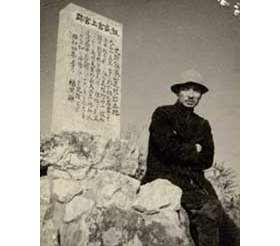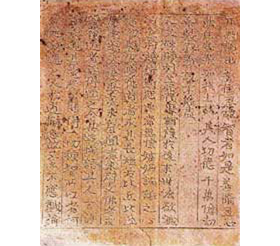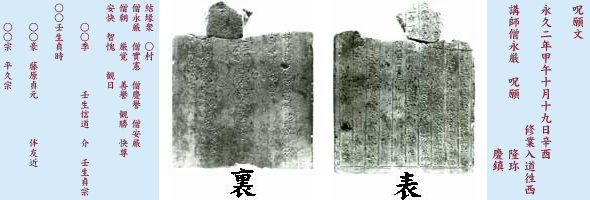Cultural Heritage
The ground of the sutra-inscribed tile exhumation
 |
 |
♣ sutra-inscribed tile
From the eleventh century through the twelfth century, the people in the Heian era when they were conscious of the arrival of the world of the degenerate age copied the Scripture flourishingly and buried it underground.
It was believed that the life of the degenerate age began in 1052 in the Christian era and was performed flourishingly mainly on this time. There is the fundamental meaning that people put in soil in the place that is going to convey a tool for Scripture and law to the world of Maitreya saving the world in place of Buddha after Buddha case extinction 70 million years after 5,600 million in this time on the basis of a sense of impending crisis of the degenerate age arrival.
The ground of the sutra-inscribed tile exhumation has a number of whole country 40 point, but it is Iimori Shrine others number point that a signature was confirmed in a round of the twelve horary years.
A Sutra of the Lotus of the Wonderful Law is the main constituent, and the Scripture seems to have much Scripture of the Shingon Buddhism including three teaching of the esoteric Buddhism. For approximately 100 years from 3 of Enkyu era to 4 of Shoan era was the time of the production.
The backgrounds include the historic example that that Honen preaches the Jodo sect of Buddhism in the next year of 4 of Shoan era.

♣ Iimori sutra-inscribed tile
The discovery of our sutra-inscribed tile was 1887, and, in the case of the ritual for rain in the Iimori-mountain Hill mountaintop of July, 1924, an accidental sutra-inscribed tile was found, and excavation was performed.
"Big native rocks" were piled up to three steps in the underground, and a carved sutra-inscribed tile was put in ten rows with 17 characters closely in a mound on the front and back both sides of the tile in the bottom.
In addition, several jars of 2 height longer than a shaku were found (one shaku is about 30cm), and put a flat stone at 4 diameter shakus, bottom of the circular hole of 4 depth shakus, and it was put carefully, but a large quantity of numerical sutra-inscribed tile excavated it after the Meiji era, but the most broke up in many houses and lost whereabouts.
By the reconstruction of estimate, 297 pieces are confirmed; 206 pieces of Lotus Sutras, 24 pieces of Sutra of Immeasurable Meanings, 21 pieces of Samantabhadra Contemplation Sutra, 39 pieces of Ninnokyo, 6 pieces of Amitabha Sutra, a piece of Pajna-para-mita Sutra.
The document of Iimori

It was recorded land belonging to a Shinto shrine division, land tax rice, an annual function in the documents from Middle Ages of Kamakura period to Nanboku-cho period.
Service charges in 32 points of Fukuoka-city cultural assets designation number in February, 1979.
It shows that Heguri has a meaning of this area in land belonging to a Shinto shrine division of the beginning in those days in the Muromachi era.

It was recorded land belonging to a Shinto shrine division, land tax rice, an annual function in the documents from Middle Ages of Kamakura period to Nanboku-cho period.
Service charges in 32 points of Fukuoka-city cultural assets designation number in February, 1979.
It shows that Heguri has a meaning of this area in land belonging to a Shinto shrine division of the beginning in those days in the Muromachi era.